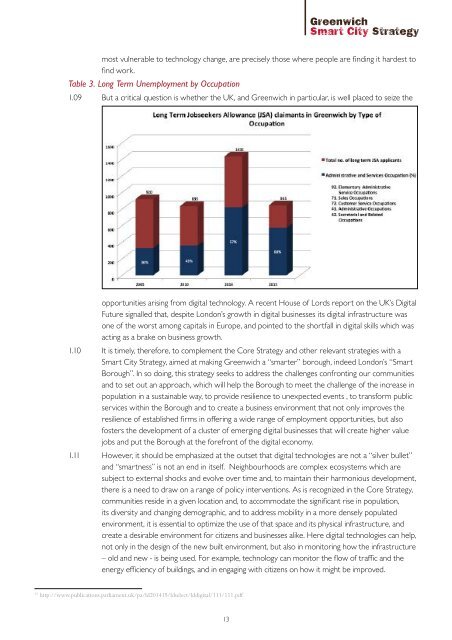Greenwich smart city strategy
You also want an ePaper? Increase the reach of your titles
YUMPU automatically turns print PDFs into web optimized ePapers that Google loves.
<strong>Greenwich</strong><br />
Smart City Strategy<br />
most vulnerable to technology change, are precisely those where people are finding it hardest to<br />
find work.<br />
Table 3. Long Term Unemployment by Occupation<br />
1.09 But a critical question is whether the UK, and <strong>Greenwich</strong> in particular, is well placed to seize the<br />
opportunities arising from digital technology. A recent House of Lords report on the UK’s Digital<br />
Future signalled that, despite London’s growth in digital businesses its digital infrastructure was<br />
one of the worst among capitals in Europe, and pointed to the shortfall in digital skills which was<br />
acting as a brake on business growth.<br />
1.10 It is timely, therefore, to complement the Core Strategy and other relevant strategies with a<br />
Smart City Strategy, aimed at making <strong>Greenwich</strong> a “<strong>smart</strong>er” borough, indeed London’s “Smart<br />
Borough”. In so doing, this <strong>strategy</strong> seeks to address the challenges confronting our communities<br />
and to set out an approach, which will help the Borough to meet the challenge of the increase in<br />
population in a sustainable way, to provide resilience to unexpected events , to transform public<br />
services within the Borough and to create a business environment that not only improves the<br />
resilience of established firms in offering a wide range of employment opportunities, but also<br />
fosters the development of a cluster of emerging digital businesses that will create higher value<br />
jobs and put the Borough at the forefront of the digital economy.<br />
1.11 However, it should be emphasized at the outset that digital technologies are not a “silver bullet”<br />
and “<strong>smart</strong>ness” is not an end in itself. Neighbourhoods are complex ecosystems which are<br />
subject to external shocks and evolve over time and, to maintain their harmonious development,<br />
there is a need to draw on a range of policy interventions. As is recognized in the Core Strategy,<br />
communities reside in a given location and, to accommodate the significant rise in population,<br />
its diversity and changing demographic, and to address mobility in a more densely populated<br />
environment, it is essential to optimize the use of that space and its physical infrastructure, and<br />
create a desirable environment for citizens and businesses alike. Here digital technologies can help,<br />
not only in the design of the new built environment, but also in monitoring how the infrastructure<br />
– old and new - is being used. For example, technology can monitor the flow of traffic and the<br />
energy efficiency of buildings, and in engaging with citizens on how it might be improved.<br />
13<br />
http://www.publications.parliament.uk/pa/ld201415/ldselect/lddigital/111/111.pdf<br />
13


